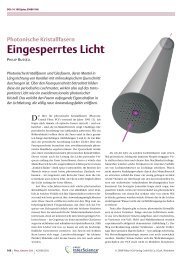Diploma thesis
Diploma thesis
Diploma thesis
Create successful ePaper yourself
Turn your PDF publications into a flip-book with our unique Google optimized e-Paper software.
2 Introduction<br />
The reason why truth is so much<br />
stranger than fiction, is that there is no<br />
need for it to be consistent.<br />
Mark Twain<br />
Quantum mechanics has been one of the most important paradigm change in physics<br />
to this day. Initiated by Max Planck with his hypo<strong>thesis</strong> of quantised black body<br />
radiation in the year 1900 and Einsteins explanation of the photoelectric effect 1905,<br />
the photon theory was one of the first achievements of quantum theory. Yet it took<br />
over 50 years for the first undeniable proof of its existence by Kimble et. al. 1977<br />
[1].<br />
It is safe to assume that neither Einstein nor Planck, at the beginning of the<br />
20th century, ever considered the generation of single photons. However, the advent<br />
of quantum information and the rapid progress in quantum information processing<br />
with linear optical gates [2] and cluster states [3] has placed high demands on<br />
the generation of single photons. Required are pure deterministic or at least pure<br />
heralded single photon states.<br />
At the dawn of the 21st century, single photon sources of all kind have emerged.<br />
They came a long way from the first experiments with strongly attenuated lasers<br />
beams some decades ago. They range from quantum dots in pillar microcavities [4],<br />
falling neutral atoms [5], trapped ions in cavities [6], defects in diamond nanocrystals<br />
[7], a single molecule in solid [8], four-wave mixing [9], to parametric downconversion<br />
[10, 11, 12]. They all display completely different approaches to the same goal,<br />
explored by scientists around the world.<br />
Until recently, it has been very difficult to generate the desired pure single photon<br />
states. In October 2007, a new type of pure heralded single photon sources has<br />
been presented [10]. The authors rely on parametric downconversion in bulk KDP,<br />
pumped by a ultrashort laser source.<br />
In this <strong>thesis</strong>, we take a deep dive into this thrilling field of nonlinear optics<br />
and theoretically investigate different methods to implement similar single photon<br />
sources. We push this approach forward, with ideas for a higher brightness and<br />
a more straightforward implementation in KTP. Waveguiding structures embedded<br />
in nonlinear crystals are a perfect candidate. They exhibit a much higher<br />
brightness than bulk crystals. We explore the possibility to shift the wavelength of<br />
the generated photons up to the telecommunication wavelength of 1550 nm, where<br />
propagation loss through optical fibers is minimal. On the experimental side, we<br />
characterised different sample waveguides in the laboratory with second harmonic<br />
generation. The results enable us to compare the developed theory with obtained<br />
3



